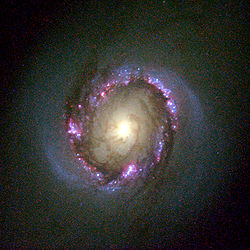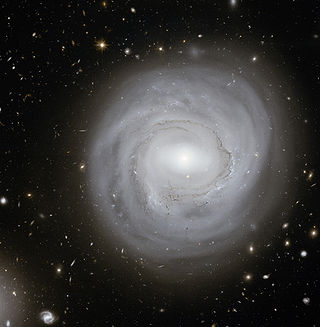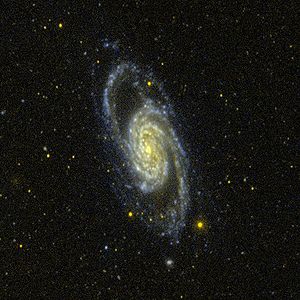
Barred spiral galaxy
Encyclopedia


Spiral galaxy
A spiral galaxy is a certain kind of galaxy originally described by Edwin Hubble in his 1936 work The Realm of the Nebulae and, as such, forms part of the Hubble sequence. Spiral galaxies consist of a flat, rotating disk containing stars, gas and dust, and a central concentration of stars known as...
with a central bar-shaped structure composed of star
Star
A star is a massive, luminous sphere of plasma held together by gravity. At the end of its lifetime, a star can also contain a proportion of degenerate matter. The nearest star to Earth is the Sun, which is the source of most of the energy on Earth...
s. Bars are found in approximately two-thirds of all spiral galaxies. Bars generally affect both the motions of stars and interstellar gas within spiral galaxies and can affect spiral arms as well.
Edwin Hubble
Edwin Hubble
Edwin Powell Hubble was an American astronomer who profoundly changed the understanding of the universe by confirming the existence of galaxies other than the Milky Way - our own galaxy...
classified these types of spiral galaxies as "SB" (spiral, barred) in his Hubble sequence, and arranged them into three sub-categories based on how open the arms of the spiral are. SBa types feature tightly bound arms, while SBc types are at the other extreme and have loosely bound arms. SBb-type galaxies lie in between. A fourth type, SBm, was subsequently created to describe somewhat irregular
Irregular galaxy
An irregular galaxy is a galaxy that does not have a distinct regular shape, like a spiral or an elliptical galaxy. The shape of an irregular galaxy is uncommon – they do not fall into any of the regular classes of the Hubble sequence, and they are often chaotic in appearance, with neither a...
barred spirals, such as the Magellanic Cloud galaxies
Magellanic Clouds
The two Magellanic Clouds are irregular dwarf galaxies visible in the southern hemisphere, which are members of our Local Group and are orbiting our Milky Way galaxy...
, which were once classified as irregular galaxies, but have since been found to contain barred spiral structures. Among other types in Hubble's classifications for the galaxies are: spiral galaxy
Spiral galaxy
A spiral galaxy is a certain kind of galaxy originally described by Edwin Hubble in his 1936 work The Realm of the Nebulae and, as such, forms part of the Hubble sequence. Spiral galaxies consist of a flat, rotating disk containing stars, gas and dust, and a central concentration of stars known as...
, elliptical galaxy
Elliptical galaxy
An elliptical galaxy is a galaxy having an approximately ellipsoidal shape and a smooth, nearly featureless brightness profile. They range in shape from nearly spherical to highly flat and in size from hundreds of millions to over one trillion stars...
and irregular galaxy
Irregular galaxy
An irregular galaxy is a galaxy that does not have a distinct regular shape, like a spiral or an elliptical galaxy. The shape of an irregular galaxy is uncommon – they do not fall into any of the regular classes of the Hubble sequence, and they are often chaotic in appearance, with neither a...
.
In 2005, observations by the Spitzer Space Telescope
Spitzer Space Telescope
The Spitzer Space Telescope , formerly the Space Infrared Telescope Facility is an infrared space observatory launched in 2003...
backed up previously collected evidence that suggested the Milky Way
Milky Way
The Milky Way is the galaxy that contains the Solar System. This name derives from its appearance as a dim un-resolved "milky" glowing band arching across the night sky...
is a barred spiral galaxy. Observations by radio telescope
Radio telescope
A radio telescope is a form of directional radio antenna used in radio astronomy. The same types of antennas are also used in tracking and collecting data from satellites and space probes...
s had for years suggested the Milky Way is barred, but Spitzer's vision in the infrared
Infrared
Infrared light is electromagnetic radiation with a wavelength longer than that of visible light, measured from the nominal edge of visible red light at 0.74 micrometres , and extending conventionally to 300 µm...
region of the spectrum has provided a more definite calculation.
The bars
Barred spiral galaxies are apparently predominate, with surveys showing that up to two-thirds of all spiral galaxies contain a bar. The current hypothesisHypothesis
A hypothesis is a proposed explanation for a phenomenon. The term derives from the Greek, ὑποτιθέναι – hypotithenai meaning "to put under" or "to suppose". For a hypothesis to be put forward as a scientific hypothesis, the scientific method requires that one can test it...
is that the bar structure acts as a type of stellar nursery, fueling star birth at their centers. The bar is thought to act as a mechanism that channels gas inwards from the spiral arms through orbital resonance
Orbital resonance
In celestial mechanics, an orbital resonance occurs when two orbiting bodies exert a regular, periodic gravitational influence on each other, usually due to their orbital periods being related by a ratio of two small integers. Orbital resonances greatly enhance the mutual gravitational influence of...
, in effect funneling the flow to create new stars. This process is also thought to explain why many barred spiral galaxies have active galactic nuclei, such as that seen in the Southern Pinwheel Galaxy
Southern Pinwheel Galaxy
Messier 83 is a barred spiral galaxy approximately 15 million light-years away in the constellation Hydra. It is one of the closest and brightest barred spiral galaxies in the sky, making it visible with binoculars...
.
The creation of the bar is generally thought to be the result of a density wave
Density wave theory
Density wave theory or the Lin-Shu density wave theory is a theory proposed by C.C. Lin and Frank Shu in the mid-1960s to explain spiral arm structure of spiral galaxies. Their theory introduces the idea of long-lived quasistatic density waves , which are sections of the galactic disk that have...
radiating from the center of the galaxy whose effects reshape the orbits of the inner stars. This effect builds over time to stars orbiting further out, which creates a self-perpetuating bar structure.
Bars are thought to be a temporary phenomenon in the life of spiral galaxies, the bar structure decaying over time, transforming the galaxy from a barred spiral to a "regular" spiral pattern. Past a certain size the accumulated mass of the bar compromises the stability of the overall bar structure. Barred spiral galaxies with high mass accumulated in their center tend to have short, stubby bars. Since so many spiral galaxies have a bar structure, it is likely that it is a recurring phenomenon in spiral galaxy development. The oscillating evolutionary cycle from spiral galaxy to barred spiral galaxy is thought to take on the average about two billion years.
Recent studies have confirmed the idea that bars are a sign of galaxies reaching full maturity as the "formative years" end. A team led by Kartik Sheth of the Spitzer Science Center at the California Institute of Technology
California Institute of Technology
The California Institute of Technology is a private research university located in Pasadena, California, United States. Caltech has six academic divisions with strong emphases on science and engineering...
in Pasadena
Pasadena, California
Pasadena is a city in Los Angeles County, California, United States. Although famous for hosting the annual Rose Bowl football game and Tournament of Roses Parade, Pasadena is the home to many scientific and cultural institutions, including the California Institute of Technology , the Jet...
discovered that only 20 percent of the spiral galaxies in the distant past possessed bars, compared with nearly 70 percent of their modern counterparts.
Grades

| Example | Type | Image | Information | Notes |
|---|---|---|---|---|
| SB0- | SB0- is a type of lenticular galaxy Lenticular galaxy A lenticular galaxy is a type of galaxy which is intermediate between an elliptical galaxy and a spiral galaxy in galaxy morphological classification schemes. Lenticular galaxies are disk galaxies which have used up or lost most of their interstellar matter and therefore have very little ongoing... |
|||
| SB0 | SB0 is a type of lenticular galaxy Lenticular galaxy A lenticular galaxy is a type of galaxy which is intermediate between an elliptical galaxy and a spiral galaxy in galaxy morphological classification schemes. Lenticular galaxies are disk galaxies which have used up or lost most of their interstellar matter and therefore have very little ongoing... |
|||
| SB0+ | SB0+ is a type of lenticular galaxy Lenticular galaxy A lenticular galaxy is a type of galaxy which is intermediate between an elliptical galaxy and a spiral galaxy in galaxy morphological classification schemes. Lenticular galaxies are disk galaxies which have used up or lost most of their interstellar matter and therefore have very little ongoing... |
|||
| SB0/a | SB0/a can also be considered a type of barred lenticular galaxy Barred lenticular galaxy A barred lenticular galaxy is a lenticular version of a barred spiral galaxy. They have the Hubble type of SB0.... |
|||
| NGC 4314 NGC 4314 NGC 4314 is a barred spiral galaxy approximately 40 million light-years away in the constellation Coma Berenices. Perhaps the most prominent and unusual feature is its "nuclear starbust ring" of bright young stars. These rings are thought to be due in part to Lindblad resonance. It is thought... |
SBa |  |
This is actually an "SB(rs)a" | |
| NGC 4921 NGC 4921 NGC 4921 is a barred spiral galaxy in the Coma Cluster, located in the constellation Coma Berenices. It is about 320 million light-years from Earth. The galaxy has a nucleus with a bar structure that is surrounded by a distinct ring of dust that contains recently formed, hot blue stars... |
SBab |  |
This is actually an "SB(rs)ab" | |
| Messier 95 Messier 95 Messier 95 is a barred spiral galaxy about 38 million light-years away in the constellation Leo. It was discovered by Pierre Méchain in 1781, and catalogued by Charles Messier four days later.-Nucleus:... |
SBb | This is actually an "SB(r)b" | ||
| NGC 3953 NGC 3953 NGC 3953 is a barred spiral galaxy located in the constellation Ursa Major.-Supernovae:Two supernovae have been identified within NGC 3953: the type Ia supernova SN 2001dp and SN 2006bp.-Environment:... |
SBbc | This is actually an "SB(r)bc" | ||
| NGC 1073 NGC 1073 NGC 1073 is a barred spiral galaxy in the constellation Cetus. It probably has a H II nucleus.... |
SBc | This is actually an "SB(rs)c" | ||
| Messier 108 Messier 108 Messier 108 is a barred spiral galaxy in the constellation Ursa Major. It was discovered by Pierre Méchain in 1781 or 1782. From the perspective of the Earth, this galaxy is seen almost edge-on.... |
SBcd | This is actually an "SB(s)cd" | ||
| NGC 2903 NGC 2903 NGC 2903 is a barred spiral galaxy about 30 million light-years away in the constellation Leo. It was discovered by William Herschel who cataloged it on November 16, 1784. NGC 2905 is a bright star cloud within this galaxy.- Additional images :... |
SBd |  |
This is actually an "SB(s)d" | |
| NGC 5398 NGC 5398 NGC 5398 is a barred spiral galaxy in the constellation Centaurus.-External links:*... |
SBdm | SBdm can also be considered a type of barred Magellanic spiral | This is actually an "SB(rs)dm" | |
| NGC 55 NGC 55 NGC 55 is a barred irregular galaxy located about 7 million light-years away in the constellation Sculptor. Along with its neighbor NGC 300, it is one the closest galaxies to the Local Group, probably lying between us and the Sculptor Group.-Nearby galaxies and group information:NGC 55 and the... |
SBm | SBm is a type of Magellanic spiral Magellanic spiral Magellanic spiral galaxies are galaxies which are classified as the type Sm . They are galaxies with one spiral arm, and are named after their prototype, the Large Magellanic Cloud, an SBm galaxy.... (Sm) |
This is actually an "SB(s)m" | |
Examples
| Name | Image | Type | Constellation Constellation In modern astronomy, a constellation is an internationally defined area of the celestial sphere. These areas are grouped around asterisms, patterns formed by prominent stars within apparent proximity to one another on Earth's night sky.... |
|---|---|---|---|
| M58 |  |
SBc | Virgo Virgo (constellation) Virgo is one of the constellations of the zodiac. Its name is Latin for virgin, and its symbol is . Lying between Leo to the west and Libra to the east, it is the second largest constellation in the sky... |
| M91 | SBb | Coma Berenices Coma Berenices Coma Berenices is a traditional asterism that has since been defined as one of the 88 modern constellations. It is located near Leo, to which it formerly belonged, and accommodates the North Galactic Pole... |
|
| M95 | SBb | Leo Leo (constellation) Leo is one of the constellations of the zodiac. Its name is Latin for lion. Its symbol is . Leo lies between dim Cancer to the west and Virgo to the east.-Stars:... |
|
| M109 | SBb | Ursa Major Ursa Major Ursa Major , also known as the Great Bear, is a constellation visible throughout the year in most of the northern hemisphere. It can best be seen in April... |
|
| NGC 1300 |  |
SBbc | Eridanus Eridanus (constellation) Eridanus is a constellation. It is represented as a river; its name is the Ancient Greek name for the Po River. It was one of the 48 constellations listed by the 2nd century astronomer Ptolemy, and it remains one of the 88 modern constellations. It is the sixth largest of the modern... |
| NGC 1365 | SBc | Fornax | |
| Magellanic Clouds Magellanic Clouds The two Magellanic Clouds are irregular dwarf galaxies visible in the southern hemisphere, which are members of our Local Group and are orbiting our Milky Way galaxy... |
SBm | Dorado, Tucana | |
See also
- Galaxy logical classification
- Galaxy formation and evolutionGalaxy formation and evolutionThe study of galaxy formation and evolution is concerned with the processes that formed a heterogeneous universe from a homogeneous beginning, the formation of the first galaxies, the way galaxies change over time, and the processes that have generated the variety of structures observed in nearby...
- Lenticular galaxyLenticular galaxyA lenticular galaxy is a type of galaxy which is intermediate between an elliptical galaxy and a spiral galaxy in galaxy morphological classification schemes. Lenticular galaxies are disk galaxies which have used up or lost most of their interstellar matter and therefore have very little ongoing...
- Spiral galaxySpiral galaxyA spiral galaxy is a certain kind of galaxy originally described by Edwin Hubble in his 1936 work The Realm of the Nebulae and, as such, forms part of the Hubble sequence. Spiral galaxies consist of a flat, rotating disk containing stars, gas and dust, and a central concentration of stars known as...
- Firehose instabilityFirehose instabilityThe firehose instability is a dynamical instability of thin or elongated galaxies. The instability causes the galaxy to buckle or bend in a direction perpendicular to its long axis. After the instability has run its course, the galaxy is less elongated than before...
External links
- Britt, Robert Roy. "Milky Way’s Central Structure Seen with Fresh Clarity." SPACE.com 16 August 2005.
- An article about the Spitzer Space Telescope's Milky Way discovery
- Devitt, Terry. "Galactic survey reveals a new look for the Milky Way." 16 August 2005.
- The original press release regarding the article above, from the Univ. of WisconsinUniversity of Wisconsin SystemThe University of Wisconsin System is a university system of public universities in the state of Wisconsin. It is one of the largest public higher education systems in the country, enrolling more than 182,000 students each year and employing more than 32,000 faculty and staff statewide...
- The original press release regarding the article above, from the Univ. of Wisconsin
- 'Barred' Spiral Galaxy Pic Highlights Stellar Birth." SPACE.com 2 March 2001.
- Hastings, George and Jane Hastings. Classifying Galaxies: Barred Spirals, 1995. "Astronomers Find Multiple Generations of Star Formation in Central Starburst Ring of a Barred Spiral Galaxy." January 15, 2000.
- A press release concerning NGC 1326
- Barred spirals come and go Sky & TelescopeSky & TelescopeSky & Telescope is a monthly American magazine covering all aspects of amateur astronomy, including the following:*current events in astronomy and space exploration;*events in the amateur astronomy community;...
April 2002. - "ESO Provides An Infrared Portrait of the Barred Spiral Galaxy Messier 83." November 29, 2001.
- A press release from the European Southern ObservatoryEuropean Southern ObservatoryThe European Southern Observatory is an intergovernmental research organisation for astronomy, supported by fifteen countries...
.
- A press release from the European Southern Observatory
- 04/03/07: Hubble: Barred Spiral Galaxy NGC 1672

